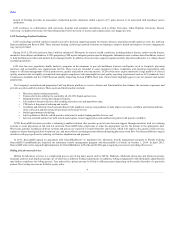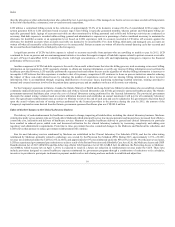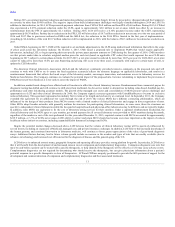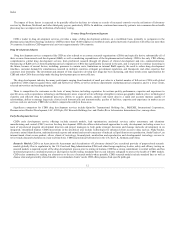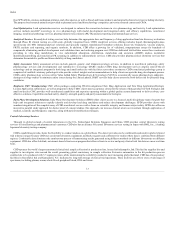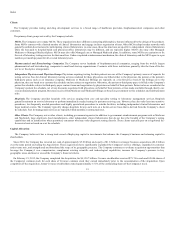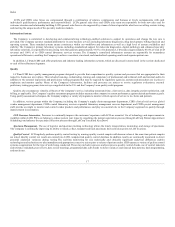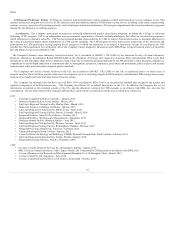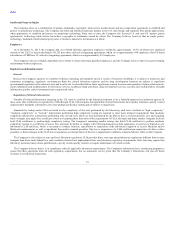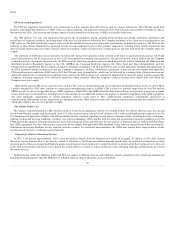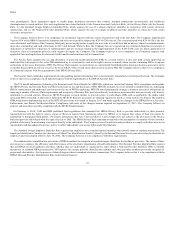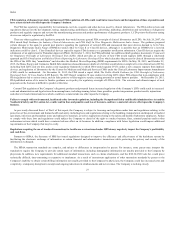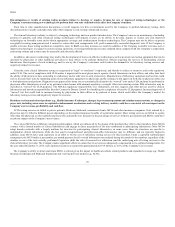LabCorp 2015 Annual Report Download - page 19
Download and view the complete annual report
Please find page 19 of the 2015 LabCorp annual report below. You can navigate through the pages in the report by either clicking on the pages listed below, or by using the keyword search tool below to find specific information within the annual report.
Index
The Company relies on a combination of patents, trademarks, copyrights, trade secrets, nondisclosure and non-competition agreements to establish and
protect its proprietary technology. The Company has filed and obtained numerous patents in the U.S. and abroad, and regularly files patent applications,
when appropriate, to establish and protect its proprietary technology. From time to time, the Company also licenses U.S. and non-U.S. patents, patent
applications, technology, trade secrets, know-how, copyrights or trademarks owned by others. The Company believes, however, that no single patent,
technology, trademark, intellectual property asset or license is material to its business as a whole.
As of December 31, 2015, the Company had over 50,000 full-time equivalent employees worldwide, approximately 19.5% of whom were employed
outside of the U.S. U.S. based subsidiaries of LCD have three collective bargaining agreements, which cover approximately 648 employees. Non-US based
subsidiaries of CDD have 23 collective bargaining agreements, which cover approximately 951 employees.
The Company’s success is highly dependent on its ability to attract and retain qualified employees, and the Company believes that it has good working
relationships with its employees.
Because the Company operates in a number of distinct operating environments and in a variety of locations worldwide, it is subject to numerous, and
sometimes overlapping, regulatory environments. Both the clinical laboratory industry and the drug development business are subject to significant
governmental regulation at the national, state and local levels. As described below, these regulations concern licensure and operation of clinical laboratories,
claim submission and reimbursement for laboratory services, healthcare fraud and abuse, drug development services, security and confidentiality of health
information, quality, and environmental and occupational safety.
Virtually all clinical laboratories operating in the U.S. must be certified by the federal government or by a federally-approved accreditation agency. In
most cases, that certification is regulated by CMS through CLIA. CLIA requires that applicable clinical laboratories meet quality assurance, quality control
and personnel standards. Laboratories also must undergo proficiency testing and are subject to inspections.
Standards for testing under CLIA are based on the complexity of the tests performed by the laboratory, with tests classified as “high complexity,”
“moderate complexity,” or “waived.” Laboratories performing high complexity testing are required to meet more stringent requirements than moderate
complexity laboratories. Laboratories performing only waived tests, which are tests determined by the FDA to have a low potential for error and requiring
little oversight, may apply for a certificate of waiver exempting them from most of the requirements of CLIA. All major and many smaller Company facilities
hold CLIA certificates to perform high complexity testing. The Company's remaining smaller testing sites hold CLIA certificates to perform moderate
complexity testing or a certificate of waiver. The sanctions for failure to comply with CLIA requirements include suspension, revocation or limitation of a
laboratory's CLIA certificate, which is necessary to conduct business, cancellation or suspension of the laboratory's approval to receive Medicare and/or
Medicaid reimbursement, as well as significant fines and/or criminal penalties. The loss or suspension of a CLIA certification, imposition of a fine or other
penalties, or future changes in the CLIA law or regulations (or interpretation of the law or regulations) could have a material adverse effect on the Company.
The Company is also subject to state and local laboratory regulation. CLIA provides that a state may adopt laboratory regulations different from or more
stringent than those under federal law, and a number of states have implemented their own laboratory regulatory requirements. State laws may require that
laboratory personnel meet certain qualifications, specify certain quality controls, or require maintenance of certain records.
The Company believes that it is in compliance with all applicable laboratory requirements. The Company's laboratories have continuing programs to
ensure that their operations meet all such regulatory requirements, but no assurances can be given that the Company's laboratories will pass all future
licensure or certification inspections.
19


